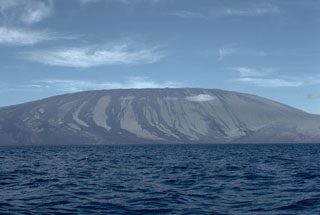Report on Wolf (Ecuador) — 27 May-2 June 2015
Smithsonian Institution / US Geological Survey
Weekly Volcanic Activity Report, 27 May-2 June 2015
Managing Editor: Sally Sennert.
Please cite this report as:
Global Volcanism Program, 2015. Report on Wolf (Ecuador) (Sennert, S, ed.). Weekly Volcanic Activity Report, 27 May-2 June 2015. Smithsonian Institution and US Geological Survey.
Wolf
Ecuador
0.02°N, 91.35°W; summit elev. 1710 m
All times are local (unless otherwise noted)
IG reported that the eruption at Wolf that began on 25 May continued through 2 June. Lava flows first reached the sea on 28 May. During an overflight on 29 May scientists observed a gas plume rising 2-3 km above the volcano and drifting NW, and smelled a strong sulfur odor. Active lava flows descended the E and NE flanks; cloud cover prevented views of the other areas but thermal images showed anomalies from lava flows on the SE and S flanks. The sulfur dioxide emission rate was 40,600 tons per day based on data collected during the flight. Satellite data collected since the beginning of the eruption indicated very minimal ash present in the plume. In addition, no ashfall was reported in the Galapagos Islands. The report also noted that activity had decreased during the recent few days.
Geological Summary. Volcán Wolf, the highest volcano of the Galápagos Islands, straddles the equator at the north end of the archipelago's largest island, Isabela. The edifice has steeper slopes than most other Isabela volcanoes, reaching angles up to 35°. The summit caldera is 6 x 7 km across and 700 m deep. A prominent bench on the west side of the caldera rises 450 m above the caldera floor, much of which is covered by a lava flow erupted in 1982. Radial fissures concentrated along diffuse rift zones extend down the N, NW, and SE flanks, and submarine vents lie beyond the N and NW fissures. Similar unvegetated flows originating from a circumferential chain of spatter and scoria cones on the eastern caldera rim drape the forested flanks to the sea. The proportion of aa lava flows exceeds that of other Galápagos volcanoes. An eruption in in 1797 was the first observed and documented in the Galápagos Islands.
Source: Instituto Geofísico-Escuela Politécnica Nacional (IG-EPN)

